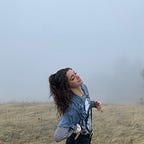Healthcare workers’ frustration with misinformation during COVID-19
Healthcare workers have been praised tirelessly for the past year. How do they feel about the public’s response to the coronavirus pandemic?
By Sala Thanassi
Word count: 815
A sign posted on the front of a gas station in Redwood City, Calif., reads in bright blue color: “Thank you healthcare heroes.”. Just beyond the sign, dozens of people march in an anti-vaccine protest on a small television screen.
Dr. Wendy Todaro, chief of occupational health and emergency medicine physician at the Palo Alto Healthcare Association, says that the sign unsettles her.
“I remember one of my patients said he didn’t believe in COVID-19 because he had seen evidence on Facebook,” Todaro said in a recent interview. “His sister got sick, he went to care for her in Los Angeles, and they both died of COVID-19 a few weeks later.”
Three Bay Area health care workers, once touted as heroes, say they no longer feel their praise to be genuine because of people who choose to ignore their public health advice.
Dr. Mark Thanassi, emergency physician at Kaiser Permanente in Santa Clara, said science shows that wearing masks and getting vaccinated makes the most sense. He says he’s frustrated with people who choose to ignore that advice.
“We were portrayed as heroes, but the actual behavior of a lot of the public was, I thought, reckless — in the sense that they weren’t following mask mandates, a certain segment of the population disregarded the vaccination mandate, and they didn’t believe in science,” he said.
Dr. Alex Thomas agrees. He believes that fewer people are wearing masks and opting for the vaccine because of misinformation.
“I fear that this has set a trend,” Thomas said, an emergency medicine physician at Kaiser Permanente in Santa Clara. “In terms of misinformation, and dangerous information.”
A March poll by NPR found that one in four Americans are unwilling to get the vaccine. Studies have shown that areas with media programming downplaying the pandemic results in higher case and death rates. It’s also been shown that there was extreme polarization in COVID-19 coverage, especially at the beginning of the pandemic. This is one of the key aspects that added to the differences in Republican versus Democratic news coverage throughout the pandemic. In their interviews, all the doctors expressed their concern over the spread of health-related misinformation.
“I’m really afraid that there was a tremendous degradation in the trust of our public health scientists,” said Todaro. “There was an increased trust in all sorts of non-scientific organizations that are just uneducating the public. I think we could face very hard times ahead if people don’t understand the fundamentals of the sciences that keep us all alive.”
An article published by the National Institute of Health says this is a “pandemic of disinformation”. Statista revealed that almost 80 percent of people in the United States reported seeing fake news on the COVID-19 outbreak. In the same study, only 26 percent of Americans said they were confident in their ability to recognize fake news. While this is happening, since March 2020 watching more news coverage has increased by 26 percent in the United States and social media consumption has increased by 16 percent.
“When there was some societal confusion about how to behave, I didn’t have any problem with that because I knew they were getting completely mixed messages,” Todaro said. “They were confusing, and changing, and sometimes politically motivated. In the case of where I worked, at the VA, we actually were under a gag order in the beginning. To not teach, express, share our knowledge. And it was a very difficult place to be.”
Misinformation had started to be seen as a more serious issue. However, countries that have tried legal approaches run into roadblocks because of no common definition for “fake news”.
“People who were non-scientists didn’t know where to look to get their information,” Todaro said. “I think that it’s sort of shocking and terrifying how far backwards our country has gone in the understanding of science, through this global pandemic. There was this opportunity for us to educate the public — what is a virus? How does it behave? How does it change? How does it affect people? How do you stay safe? We understand viruses, we know how to do this, but we didn’t teach society. We didn’t teach the public. And so, we actually went backwards, to all sorts of, you know, mythology and crazy diagnostics and behaviors that were non-scientific.”
“I hope we can adapt to deal with this misinformation,” Thanassi said. “It’s here, and we can’t trust the American public to tell what’s real and what’s not on their own. We failed in this test, and there might come another one, and we should be better prepared.”
